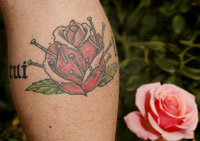Getting inked and employed

Andrew Riggs / The Collegian
Fresno State student Kaleb Schneider’s three tattoos are strategically placed so that the senior business major can cover them easily for job interviews and work.

|
By Jeff Christian
The Collegian
Tattoos and body piercings are becoming increasingly popular among college students because they provide an opportunity to make a statement and can also act as a form of rebellion for individuals outside parental supervision for the first time.
Whether it’s a spontaneous impulse to get a random design on their backs or a thorough and exhausting decision to get the name of a beloved family member inked forever, tattoos are seeping into the mainstream.
However, despite the increase, a visible ink design or a metal piece of “bling” can have a detrimental effect on students’ ability to find a job or start their careers after graduation.
“It definitely is something that right now will have an impact on what employment is available to them depending on whether the tattoos or other body modifications are visible,” Fresno State Career Services Director Rita Bocchinfuso-Cohen said.
The severity of the consequence of such a personal statement depends greatly on the career field and geographic area students are interested in.
“If you’re planning to be self-employed, then it’s probably not going to be an issue at all. If you’re planning on working in something like the arts or something less conservative and creative then it’s going to have less of an impact on a student’s career opportunities. But, the Central Valley tends to be more conservative. The employers here, the organizations and the culture are a more conservative culture than some of the other coastal cities in California,” Bocchinfuso-Cohen said.
Kaleb Schneider, a senior business major, has two tattoos on his back and another on his calf. Although Schneider has had the back tattoos for over three years, the tattoo on his leg was added only three months ago.
“I thought about the tattoo on my leg for a really long time. I mulled it over for about a year before getting it,” Schneider said.
Although highly visible when wearing shorts, Schneider said he doesn’t expect any negative implications for him in the job market because most of the time people are required to wear pants at work.
For example, the dress code at the restaurant where Schneider works requires him to be fully clothed head-to-toe with long sleeves.
While the tattoos on his back and leg aren’t visible, Schneider said that he is contemplating adding a much more noticeable tattoo on his wrist. Schneider has a plan to strategically disguise a new tattoo on his wrist.
“I can always cover it up by wearing a watch,” Schneider said.
Schneider believes that the negative stereotype associated with tattoos stems from the ‘50s and ‘60s when people with tattoos weren’t traditionally regarded as being successful.
Christy Collet, a 19-year-old physical therapy student, has several piercings in the bottom of her ear, a nose piercing and a tattoo on her side.
Collet described the 18 black outlined stars inked on her right side as a gut shot decision one day after school.
“The main reason I got it on my side was so that it wouldn’t interfere with job interviews,” Collet said.
While her tattoo is not visible, Collet believes that her piercings made it slightly more difficult when she was applying for jobs.
“I got turned down for a few jobs because my nose ring and ear piercing turned some people off,” Collet said.
Bocchinfuso-Cohen warns that if students are dead set on getting something that is highly visible, they should be prepared to face disappointment when applying for jobs.
“If somebody really wants to have something that’s visible they need to know that there is probably going to be discrimination against them, just maybe not overt. It will make you a target for finding other reasons for making you not an acceptable candidate,” Bocchinfuso-Cohen said.
Students who already have permanent jobs and are contemplating getting some ink or a piercing are recommended to examine how it will be perceived in their line of work before proceeding.
“Most employers are going to offer the chance to accommodate with what somebody has even if it’s not the most ideal because they don’t want to run into problems with discrimination,” Bocchinfuso-Cohen said.
Amy Roinestead, a senior accounting major, got her nose pierced during her freshman year and kept it for almost two years.
“I liked it, I thought it was cute and I was 18,” Roinestead said.
Prior to removing the nose ring, Roinestead applied for a job at a mortgage company. She said that she left her nose ring in during her job interview, but the interview wasn’t formal.
The nose ring didn’t prevent Roinestead from getting the job. However, after being hired, she replaced her nose ring with a clear one while at work.
“I personally felt more comfortable not having it on at work because it’s more social than professional,” Roinestead said.
Students contemplating a visible tattoo or piercing are recommended to wait until after they hired.
“If you’re on the fence, if you’re not the stellar candidate, you don’t want hurt your chances with something minor,” Bocchinfuso-Cohen said. “You might want to go conservative, get the job first, and then take a look around to see how much leeway you have.”
Comment on this story in the Features forum >>
|
